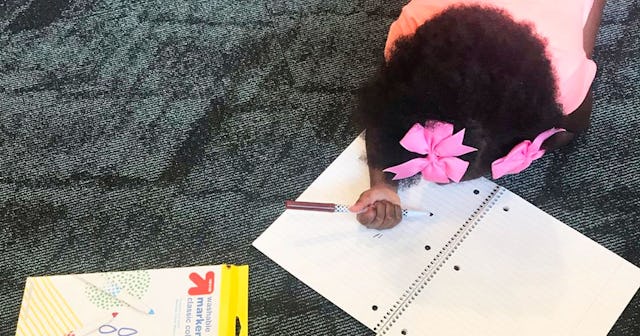Forcing Preschoolers To Write Too Young Is Pointless

I remember sitting at the kitchen table with my first child, repeatedly reminding her to hold her crayon the “right way.” You know what I mean. That tripod grip that preschool teachers are always talking about.
But my child wasn’t four or five. She was a toddler, still in diapers. Yet I was determined that she wouldn’t fall behind. And not only that, as a first-time mom, I wanted her to be ahead of her peers. Probably so I could brag about her mad handwriting skills to other moms at the park.
She was the same kid whom I made sure could communicate her needs using baby sign language. I thought she was the most brilliant baby on the planet when she said “grandma,” ditched the daytime diapers, and slept all night in a toddler bed.
Now I have four kids, and I’ve learned to chill out when it comes to developmental skills. Some kids take longer than “the norm” to obtain a particular skill—whether that be writing their letters, naming their colors, potty training, sleeping through the night, or kicking the pacifier addiction. And guess what? It’s OK.
Need further convincing? Check out this side-by-side X-ray comparing the hand of a seven-year-old child to that of an EYFS child. EYFS stands for Early Years Foundation Stage, which represents children under age five.
Notice the differences? Those distinctions make a difference in a child’s ability to practice fine motor skills such as writing, using scissors, zipping, and picking up small objects. Younger children’s hands simply aren’t ready for mad fine motor skills.
My guess is many parents, and educators, don’t realize that they’re pushing children to do things their bodies aren’t yet designed to do. Instead, they’re like me during my early parenting years—pushing their children to not only keep up with peers, but excel. After all, aren’t we preparing our children for their college years and future careers?
Before you abandon your commitment to your child’s education, you need to know that handwriting is important to learning. Like really important. But timing is everything.
Melissa McKaig, a school occupational therapist, told Scary Mommy, “Research shows that handwriting fully engages the brain, improves memory, enhances focus, unleashes creativity, and calms the body and nerves.” And she says, all of these handwriting perks support the child in the academic environment.
Yes, there are benefits to handwriting. However, McKaig further explains that parents absolutely need to chill out when it comes to their kid’s fine motor skill development. She told Scary Mommy that we need to take a step back and “consider their child’s developmental age, keeping in mind that all children develop physical, cognitive, and social/emotional skills at different rates.”
And here’s the kicker. McKaig stated, “Fine motor skills develop as gross motor skills allow stability to explore their environment.”
Wait. What? So instead of pushing our three-year-olds to cut in a straight line, we should take them to the park?
McKaig told Scary Mommy kids need to engage in play that uses the senses. And we need to remember that children are not meant to sit still and be quiet. She encourages parents to take advantage of their environment. Vary the textures and tools available. Add music and make everyday activities a game. The more the entire body moves and the more fun it is for the child, the better.
Handwriting is important to learning. Like really important. But timing is everything.
She suggests that instead of making a child practice writing a single letter over and over, using pencil and paper, bring on a sensory experience. Have the child form letters using Play Doh. The demanding and developmentally inappropriate task of repeated practice will only feel like a punishment.
Likewise, she encourages us to let our kids hang from the monkey bars. Why? Doing so strengthens the child’s hands. Plus, we all know our kids sleep better after some hardcore outside play.
Basically, we need ditch the workbooks and get our children moving. What a relief this advice is! Because trying to force, manipulate, or bribe a young child to sit and write their name is torture.
So, I’m going to call this winning. Because yes, my toddler can spell her name in sing-song fashion. But no, she—as my fourth child—cannot write her name or any of the letters in her name. And it’s fine. Because she’s racing friends down the slide, playing with her tween sister’s slime, and learning songs about the alphabet instead.
Now, this isn’t to say you should completely abandon your parental obligations. By age five, McKaig said your child should be able to be learning to print numbers and letters and consistently use one hand for fine motor tasks.
By age seven, your child should be printing words, print neatly within the lines, cut out art projects—while staying within the lines, coloring inside the lines, draw recognizable pictures, begin open packages independently, and self-dress—including manipulate most fasteners.
It’s important to note the two-year range, allowing time for skill development at the child’s own pace.
Parents are both their child’s teachers and observers. Because sometimes a child is developmentally delayed. Red flags that parents should look out for in their school-age child’s fine motor skills include a child being indecisive about which hand they prefer. Also, stiff or shaky movements are concerning.
Further issues include weak hands and arms, an inability to draw basic shapes—including a cross, an inability to cut along straight or curved lines, and significant difficulty printing letters and numbers.
If you see red flags in your child’s fine motor skills, McKaig encourages you to make a list of your concerns. Then take this list to your child’s pediatrician and public school or private evaluators. They will help you determine the next steps to take.
Let your preschooler color outside the lines. You’ll both be happier.
This article was originally published on